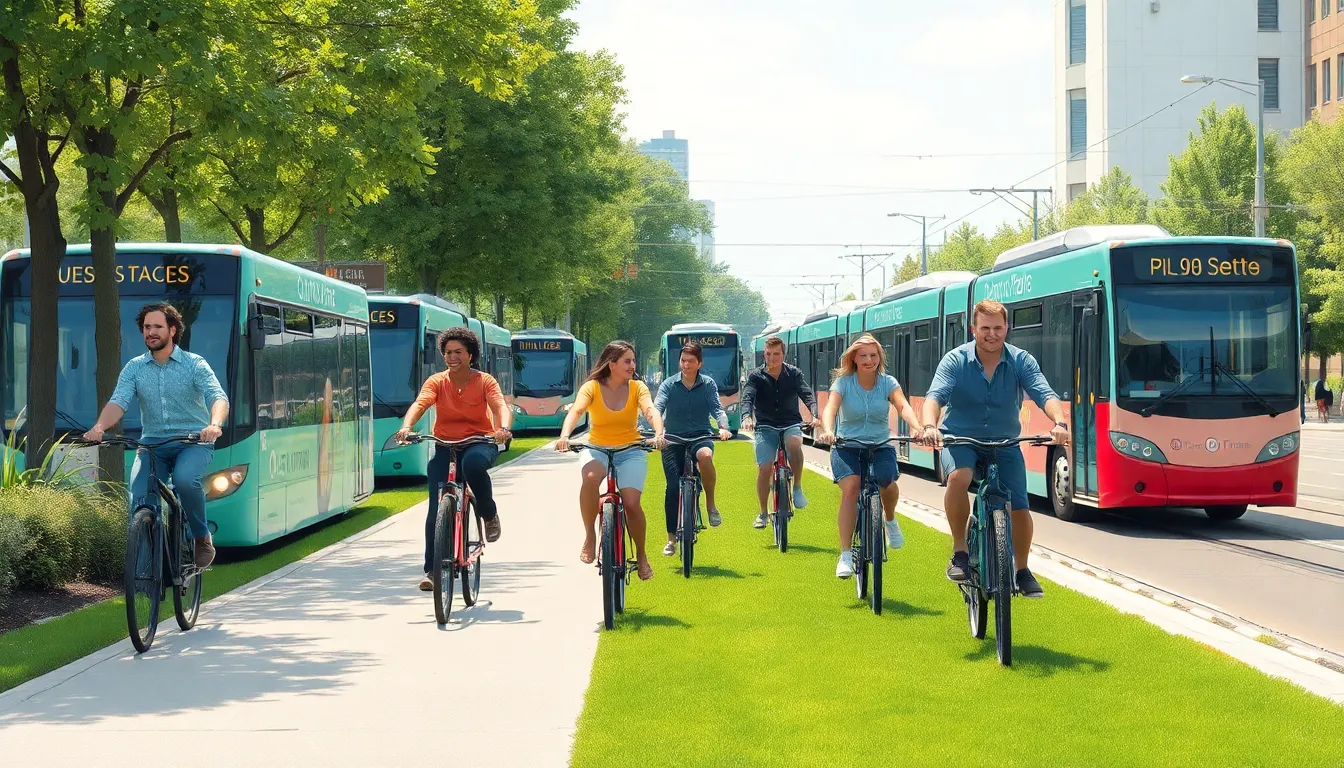In a world where traffic jams and air pollution often feel like the new normal, clean transport solutions are stepping in like superheroes on wheels. Imagine zipping through the city in a vehicle that doesn’t just get you from point A to point B, but does so while giving Mother Earth a high-five. It’s not just a dream—it’s the future of transportation.
Table of Contents
ToggleOverview of Clean Transport Solutions
Clean transport solutions encompass various innovative strategies aimed at reducing environmental impact. Electric vehicles (EVs) serve as a primary example, powered by renewable energy sources to minimize greenhouse gas emissions. Additionally, public transportation systems, including electric buses and trams, enhance urban mobility while lowering individual carbon footprints.
Bike-sharing programs contribute to this landscape by encouraging cycling as a viable alternative to car travel. Many cities are implementing bike lanes and infrastructure improvements, promoting this eco-friendly mode of transport. Similarly, pedestrian-friendly urban designs facilitate walking, fostering healthier lifestyles and reducing reliance on motor vehicles.
Carpooling and ride-sharing services also play significant roles in minimizing traffic congestion and emissions. Individuals sharing rides can reduce the number of vehicles on the road, leading to less pollution. Moreover, advances in technology promote the development of smart transportation systems, optimizing routes and improving efficiency.
Hydrogen fuel cells present another clean transport solution, utilizing hydrogen to generate electricity for vehicles. This technology emits only water vapor, making it an environmentally friendly alternative to fossil fuels. Furthermore, alternative fuels such as biofuels and compressed natural gas offer options that can power vehicles with lower emissions.
Integration of these various solutions creates a holistic approach to clean transportation. Solutions not only address environmental issues but also enhance urban living standards. As cities embrace these technologies and practices, the potential for a sustainable transport future becomes increasingly attainable.
Benefits of Clean Transport Solutions

Clean transport solutions offer significant advantages for individuals, communities, and the planet. They contribute to a sustainable future by addressing critical issues like air quality and urban congestion.
Environmental Impact
Clean transport solutions play a crucial role in reducing emissions and improving air quality. Electric vehicles produce zero tailpipe emissions, significantly decreasing urban air pollution. Public transport systems like electric buses and trams help minimize individual environmental footprints by lowering the number of cars on the road. Bike-sharing programs encourage cycling, further reducing vehicle dependency. These initiatives also enhance biodiversity and support sustainable urban planning. Smart transportation systems optimize traffic flow, decreasing fuel consumption while promoting more environmentally friendly travel options. Collectively, these benefits lead to healthier urban environments and reduced greenhouse gas emissions.
Economic Advantages
Clean transport solutions drive economic growth through job creation and improved efficiencies. The electric vehicle industry alone expects to generate over 10 million jobs globally by 2030. Public transport systems reduce overall commuting costs for individuals, encouraging increased use. Carpooling and ride-sharing platforms can save users money on fuel and maintenance, decreasing their overall transportation expenses. Lower emissions often lead to reduced healthcare costs associated with pollution-related health issues. When smarter, cleaner transport options become widely adopted, cities can experience increased productivity, spurring further investment and economic development.
Types of Clean Transport Solutions
Clean transport solutions encompass various innovative strategies that enhance mobility while reducing environmental impact. Each type serves a unique purpose, contributing to a sustainable future.
Electric Vehicles
Electric vehicles (EVs) are key players in reducing greenhouse gas emissions. They run on electricity rather than fossil fuels, leading to zero tailpipe emissions. Charging stations powered by renewable energy sources further support their sustainability. The growing market for EVs includes a wide range of models, from compact cars to larger vehicles, which makes them accessible to a wider audience. Additionally, advancements in battery technology increase their efficiency, enabling longer travel distances on a single charge.
Hydrogen-Powered Vehicles
Hydrogen-powered vehicles utilize fuel cell technology to generate electricity. By converting hydrogen and oxygen into energy, these vehicles emit only water vapor, making them environmentally friendly. The infrastructure for hydrogen refueling is expanding, with more stations becoming available. Moreover, hydrogen fuel cells offer rapid refueling times, comparable to traditional gasoline vehicles. The potential for hydrogen in public transit and freight transportation highlights its versatility and role in achieving clean transport goals.
Public Transit Innovations
Innovations in public transit play a crucial role in promoting clean transport solutions. Electric buses and trams contribute to reduced emissions while enhancing urban mobility. Contactless payment systems and real-time tracking improve user experience, encouraging more individuals to use public transit. Furthermore, the integration of smart technology optimizes routes, increasing efficiency and reducing wait times. These advancements ensure that public transport systems remain attractive alternatives to private vehicle use, significantly lowering individual carbon footprints.
Challenges in Implementing Clean Transport Solutions
Implementing clean transport solutions presents several challenges that must be addressed. These obstacles can hinder the transition to a more sustainable transportation system.
Infrastructure Limitations
Infrastructure limitations pose significant challenges to clean transport adoption. Many cities lack the necessary charging stations for electric vehicles, restricting access for potential users. Public transit systems often require extensive upgrades to accommodate electric buses and tram networks. Existing roads may need enhancements to support increased bicycle traffic safely. Without investment in infrastructure, initiatives like bike-sharing programs struggle to thrive, limiting their effectiveness. Roadway designs may not prioritize pedestrian access, making walking less viable. These inadequacies contribute to an environment that does not facilitate the shift to cleaner alternatives.
Cost Barriers
Cost barriers significantly impact the adoption of clean transport solutions. High initial investments deter individuals and businesses from purchasing electric vehicles, despite their long-term savings. Infrastructure upgrades demand substantial upfront expenditure, which can strain municipal budgets. Affordability of renewable energy sources plays a crucial role in operating clean transportation systems sustainably. Additionally, maintenance costs for advanced technologies can be higher than traditional systems. Economic incentives, while beneficial, may not cover the full financial burden. These financial challenges necessitate strategic planning to promote wider acceptance of clean transport initiatives.
Future Trends in Clean Transport Solutions
Innovations in clean transport solutions anticipate significant changes in the coming years. Electric vehicles (EVs) continue to lead the charge, driven by advancements in battery technology and increasing reliance on renewable energy sources. Growth in EV adoption impacts urban air quality positively by reducing greenhouse gas emissions dramatically.
Public transportation also trends toward electrification. Electric buses and trams are becoming standard in many cities, enhancing operational efficiency and lowering emissions. Transitioning to electric public transport significantly alleviates individual carbon footprints.
Smart transportation systems emerge as crucial players. Real-time data integration helps optimize routes and manage traffic flow effectively. For instance, smart traffic signals adapt based on current traffic patterns, reducing congestion and travel times.
Hydrogen fuel cells are gaining traction as well. These systems provide an efficient alternative for heavy-duty vehicles, emitting only water vapor. Expanding hydrogen refueling infrastructure supports this growth, making it a viable option for commercial transport.
The bike-sharing model continues to expand. Cities are increasing bike-share programs, improving accessibility to cycling as a mode of transport. Enhanced bike lanes and pedestrian-friendly initiatives create a more inviting environment for non-motorized travel.
Carpooling and ride-sharing platforms adapt to meet rising demand for sustainable transport options. These services connect users while reducing the number of vehicles on the road, effectively cutting emissions.
Focus on policy development is crucial. Governments are implementing incentives to encourage the adoption of clean transport solutions. These measures boost funding for infrastructure development and promote research into alternative fuel sources.
Collectively, these trends indicate a shift toward a more sustainable transport future. Each advancement contributes to a holistic approach, addressing both environmental concerns and urban mobility needs efficiently.
The shift towards clean transport solutions marks a pivotal moment in addressing urban challenges. Embracing electric vehicles public transit innovations and alternative fuels can significantly enhance air quality and reduce congestion.
As cities evolve to incorporate smart transportation systems and promote cycling and walking, the benefits extend beyond environmental impact. Economic advantages and healthier lifestyles emerge as communities adapt to these sustainable options.
With continued investment in infrastructure and supportive policies the vision of a cleaner more efficient transport future is within reach. This commitment not only improves urban living standards but also fosters a collective responsibility towards a sustainable planet.




